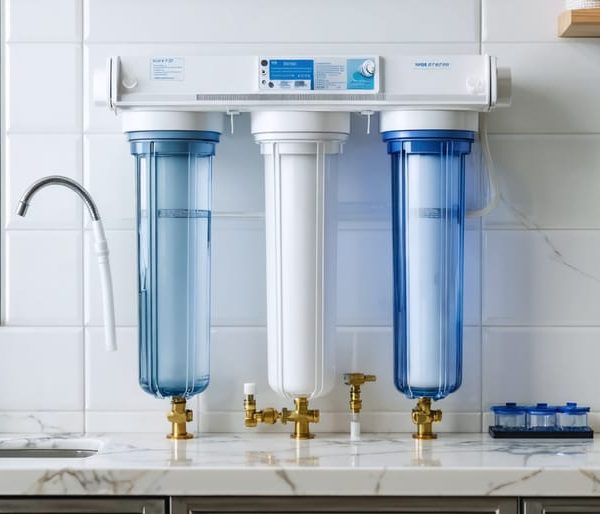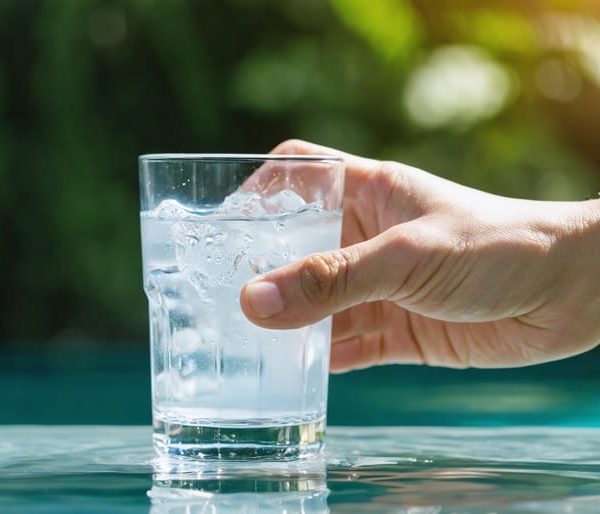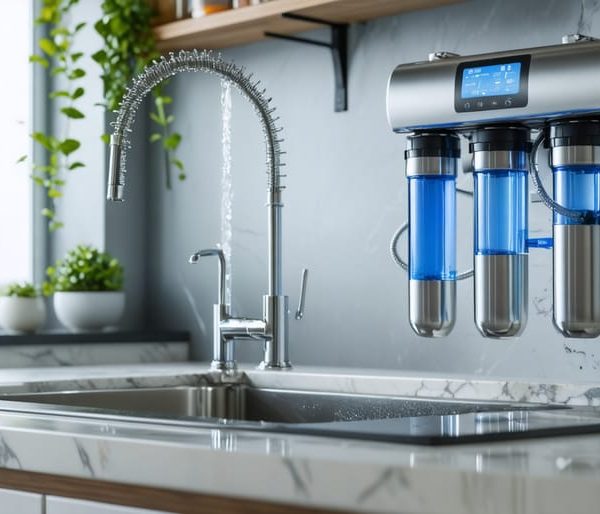The most common way to soften hard water is via ion exchange. This method works by eliminating minerals and ions that cause water hardness. Some other methods work by conditioning the mineral elements in the water. These are mainly salt-free systems. Boiling water and using washing soda are also simple but effective ways to water softening.
Checking Your Water Hardness Levels
Before you decide to soften your water, you must carry out an analysis of your water supply. You can use a water test kit to check, analyze your local municipal water report or test your water hardness at home.
The amount of magnesium and calcium minerals in the water determines the level of water hardness by grains per gallon gpg. Hard water starts becoming a real concern when the level surpasses 3.5 gpg. At over 10 gpg, the water is considered very hard. It contains significant amounts of dissolved minerals, including iron. They are responsible for mineral buildup, which clogs pipes and results in the stiff laundry. Levels of magnesium and calcium will rise above 3.5 gpg in hard water.
11 Methods of Softening Water
The method you choose to soften hard water depends on several factors, including your budget, the capacity you require, whole house or point-specific softeners, and the type of water softener.
1. Water Softener
Water softeners deal with the mineral deposits in your water supply. A water softening system uses two separate tanks, brine and resin tanks. The system needs to regenerate in order to replenish the salt. This system also eliminates dissolved iron minerals in the water supply.
Water from your main supply mixes with resin beads coated with sodium or potassium ions. Calcium and magnesium mineral ions are swapped with the sodium ion present in the resin beads. This process softens the hard water.
Bags of salt (sodium) are topped up in the brine tank. Some of the common types of water softener salt include rock salt, evaporated salt, and solar salts. After topping up the salt, ion exchange occurs, replacing hard mineral ions and flushing out wastewater.
Some versions come with dual tanks. There are two connected ion exchange tanks. These are important to avoid any downturn in the supply of soft water. If one tank is regenerating, the other one is activated to continue supplying water to the household. Dual tank ion exchange systems are best for large households.
Note that ion exchange water softeners are not recommended for people who have cardiovascular conditions. The sodium concentration in the water may negatively affect their condition.
2. Reverse Osmosis Systems
An RO system is typically known for its water purifying capabilities. It filters down water up to the molecular level. Due to the use of multiple fine filters, mineral ions that make water hard are also filtered out.
With this water softening system, you are guaranteed soft water without the need for salt-based ion exchange processes. The water you get is also free from pathogens and chemicals.
RO systems are point-specific. They are normally deployed in the kitchen to ensure the tap water consumed in the house is clean.
There are some drawbacks to RO systems. Due to the rigorous filtering system, all human-friendly minerals are filtered out as well. The filter also becomes ‘dirty’ with time and needs periodic replacement.
3. Salt-Free Water Softeners
Salt-free softeners like the Springwell FutureSoft are also referred to as salt-free water conditioners. Unlike ion exchange systems, salt-free water systems do not eliminate hard water ions. In an actual sense, the salt-free system works like a water conditioner. Ion exchange systems are therefore superior in eliminating the hardness minerals.
With salt-free systems, calcium and magnesium are only conditioned. These mineral ions can provide health benefits in drinking water without the risk of adding sodium-based salts.
Limescale buildup is also limited. If it occurs, it is easy to remove since it does not build up in the pipes. Water conditioners only last for a limited period. This scenario is expedited when the water is left standing for a long period or it goes through the heating system continuously. The result is that the calcium and magnesium ions get reactivated.
The advantage of salt-free systems is less wastewater, ease of installation, no sodium use, and little maintenance.
4. Magnetic Water Conditioners
They are sometimes referred to as electronic water softeners or descalers. They primarily work by generating an electromagnetic field.
A magnetic water softener is a small unit that is connected to the water supply line. To soften water, the system generates an electromagnetic field that conditions the mineral ions. The ions present in the water repel the pipe and each other, limiting the chances of mineral deposits building up.
Users should note that a magnetic water softener will not deal with hard water. Hard water will persist but will not scale on the pipes. Reviews for these systems have elicited opposing opinions. Some users were very pleased, while others claimed the system is not really effective.
5. Showerhead Water Softener
Mineral ions and contaminants are filtered out when the water leaves the faucet. A filter limits the buildup of limescale which affects the water flow due to clogging.
Softened water is beneficial to your hair and skin. Showering with hard water leads to skin irritation and dry skin. You will also feel cleaner due to the elimination of soap scum.
6. Metered or Timed Regeneration System
Like ion exchange systems, demand-initiated softeners are also popular. The system is able to regenerate when required and continually provide soft water.
The only drawback is that the system may not be able to match your needs during peak periods when you require a lot of water.
7. Template Assisted Crystallization (TAC) System
TAC systems utilize a unique technology that performs clustering. The cluster is between magnesium and calcium ions that are then separated from the water. The mineral cluster is stable and is not reactive when exposed to scale or scum.
8. Washing Soda
Not long ago, people were adding lime or washing soda to their water. The method is effective where water has been stored.
Washing soda contains sodium bicarbonate. They bind the mineral ions and other sediments present in the hard water, which eventually settle at the bottom of the storage container. The process takes several days. Soft water can be fetched from the top of the storage container after that period. The drawback of this method is the need to wait for several days before the softening process is completed. It also means the method requires large storage containers which will hold enough water.
The soft water from this method is also effective when doing laundry. Water will lather easily, although it is only a temporary solution. Since the limescale is not completely eliminated, it will affect your laundry in the long run through fading.
9. Boiling Water
Boiling is an easy way to deal with temporary hardness in water. It is useful for softening water for consumption on a small scale. Allow the water to cool and settle down. The minerals will settle at the bottom of the boiling point.
Temporary hardness means that the water contains calcium bicarbonate that dissolves upon boiling. If your water has a permanent hardness, boiling will not result in softer water.
10. Distilled White Vinegar
White vinegar is acidic in nature and neutralizes the calcium minerals in hard water. It is useful for cleaning. For instance, you can pour a bit of vinegar when you are hand washing your clothes or utensils.
11. Hard Water Cleaning Aid
The cleaning aid assists in removing soap scum. Hard water contains minerals that result in the creation of scum. There are also store-bought products that do this for you. They counter the calcium in the hard water. They prevent the scum from forming, and that leads to easy rinsing.
Our Final Thoughts
We have examined how to soften hard water. Two methods really stand out; salt-free and salt-based methods. The primary goal is to remove or condition minerals such as magnesium, calcium, and iron.
It is also possible to soften water on a small scale. Methods like boiling work against temporary hardness. Using washing soda is also viable but works where water is stored. Other methods like reverse osmosis work as a water softener but still work to provide drinking water.



